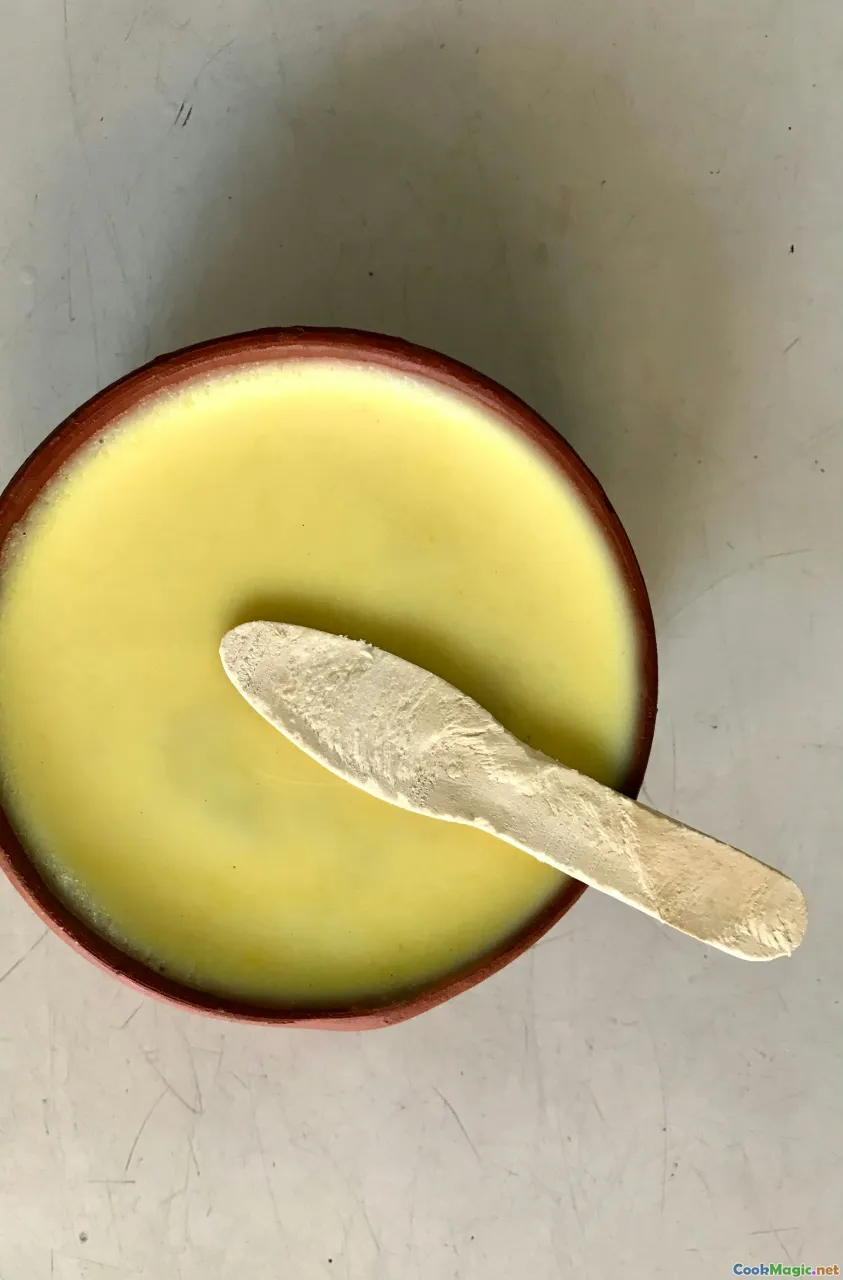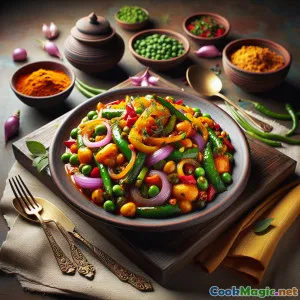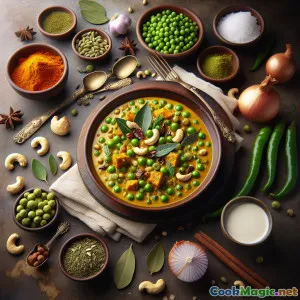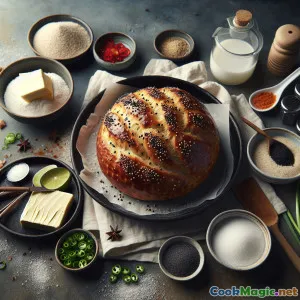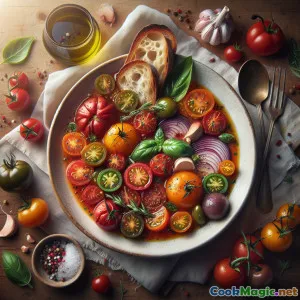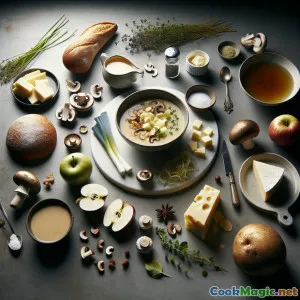
Resep Sup Hutan Krim dengan Keju Gruyère & Apel
(Creamy Gruyère & Apple Woodland Soup Recipe)
(0 Ulasan)0
703
Juli 29, 2025
Laporkan Masalah
Bahan
-
100 grams Keju Gruyère
(Parutan kasar)
-
2 medium Apel Cox atau Braeburn
(Peeled, cored, and diced; firm sweet-tart apples are ideal)
-
200 grams Jamur Hutan
(Hedgehog, chanterelle, or mixed woodland varieties)
-
1 large Bawang daun
(White and light green part only, sliced)
-
1 medium Kentang
(Dikupas dan dipotong dadu)
-
750 ml Kaldu Sayuran
(Preferably homemade or low salt)
-
120 ml Krim ganda
(For extra silkiness)
-
30 grams Mentega
(Tanpa garam)
-
2 sprigs Thyme
(Fresh, leaves picked)
-
2 tbsp Chives
(Cincang halus, plus tambahan untuk hiasan)
-
0.5 tsp Garam
(Sesuai selera)
-
0.25 tsp Lada hitam
(Giling segar)
-
15 grams Hazelnut
(Chopped and toasted, for garnish)
-
4 slices Roti sourdough renyah
(Untuk disajikan)
(Parutan kasar)
(Peeled, cored, and diced; firm sweet-tart apples are ideal)
(Hedgehog, chanterelle, or mixed woodland varieties)
(White and light green part only, sliced)
(Dikupas dan dipotong dadu)
(Preferably homemade or low salt)
(For extra silkiness)
(Tanpa garam)
(Fresh, leaves picked)
(Cincang halus, plus tambahan untuk hiasan)
(Sesuai selera)
(Giling segar)
(Chopped and toasted, for garnish)
(Untuk disajikan)
Nutrisi
- Porsi: 4
- Ukuran Porsi: 1 mangkuk (300ml)
- Calories: 355 kcal
- Carbohydrates: 0 g
- Protein: 11 g
- Fat: 19 g
- Fiber: 5 g
- Sugar: 11 g
- Sodium: 637 mg
- Cholesterol: 55 mg
- Calcium: 320 mg
- Iron: 2.1 mg
Instruksi
-
1 - Prepare Produce and Ingredients:
Wash, peel, and dice the apples and potato. Slice leek into rings, clean wild mushrooms, and grate the Gruyère cheese. Chop thyme leaves and chives.
-
2 - Sauté Vegetables & Apples:
In a large saucepan, melt butter over medium heat. Add leek, cook until softened but not browned. Stir in apples, potato, mushrooms, and half of thyme. Sauté for 5-7 minutes until apples turn slightly golden.
-
3 - Simmer the Soup:
Pour in vegetable stock, cover, and bring to a gentle simmer. Cook for 15-18 minutes or until potatoes are entirely soft and apples collapse.
-
4 - Blend and Add Dairy:
Off the heat, remove thyme sprigs. Use a hand blender to purée soup until silky. Stir in double cream, grated Gruyère, remaining thyme, salt, and pepper. Gently heat while stirring until cheese melts into the soup.
-
5 - Serve and Garnish:
Ladle into warm bowls. Garnish generously with toasted hazelnuts and chives. Serve with warm crusty sourdough bread.
Wash, peel, and dice the apples and potato. Slice leek into rings, clean wild mushrooms, and grate the Gruyère cheese. Chop thyme leaves and chives.
In a large saucepan, melt butter over medium heat. Add leek, cook until softened but not browned. Stir in apples, potato, mushrooms, and half of thyme. Sauté for 5-7 minutes until apples turn slightly golden.
Pour in vegetable stock, cover, and bring to a gentle simmer. Cook for 15-18 minutes or until potatoes are entirely soft and apples collapse.
Off the heat, remove thyme sprigs. Use a hand blender to purée soup until silky. Stir in double cream, grated Gruyère, remaining thyme, salt, and pepper. Gently heat while stirring until cheese melts into the soup.
Ladle into warm bowls. Garnish generously with toasted hazelnuts and chives. Serve with warm crusty sourdough bread.
Informasi Lebih Lanjut: Resep Sup Hutan Krim dengan Keju Gruyère & Apel
Summary & Story
Gruyère & Apple Woodland Soup offers a refined yet deeply comforting taste of English woodland cuisine, borrowing from traditional British root-vegetable soups and the cheese-making culture of the Anglo-French border. Beneath its silky exterior, it surprises with layers of nutty Gruyère, the gentle tartness of ripe English apple, earthy wild mushrooms, and aromatic fresh herbs. The toasted hazelnut garnish draws inspiration from British woodlands, where both nuts and mushrooms are found flourishing in cooler autumn months.
Tips & Notes
- For a kitchen shortcut, supermarket wild mushroom mixes work well, though fresh hedgehogs, chanterelles, and chestnut mushrooms will yield the richest woodland aroma.
- Cox, Braeburn, or other slightly tart, firm apples contrast beautifully with creamy soup. Avoid mealy varieties that will disintegrate.
- For vegans, swap Gruyère for a plant-based cheese, double cream for oat or cashew cream, and use vegan butter for sautéing.
- Whizzing the soup with a hand blender gives a rustic texture, but a countertop blender yields ultra-velvety results. Always blend in batches if hot.
- Toasting hazelnuts boosts their flavor: scatter nuts on a dry pan over medium heat until fragrant, then chop when cool.
History & Cultural Significance
This recipe nods to England’s enduring love of soups made from local produce, especially as the days turn cool. Cheese-and-apple pairings are steeped in British culinary heritage: cheddar-and-apple pie, ploughman's lunches, and cheese-topped fruit breads feature regularly in rural menus. The bloom-rinded Gruyère, while Swiss in name, reflects English influence from the cathedral towns of Gloucester to Cheddar Gorge, where artisans have adapted continental cheese to local climates and tastes envisioning farmstead comfort and continental flair. There’s also a growing tradition in modern English cuisine to incorporate foraged elements—wild mushrooms, hedgerow nuts, and local herbs—and to create dishes evoking autumnal scenes of English woodland rambles after scattered rain.
Cheese soups are jovially discussed in 18th-century English recipe books and community cook-offs—usually combining robust local leeks or onions with sheep's- or cow’s-milk cheese. The addition of apple isn’t just poetic; it’s a centuries-old solution for balancing richness with home orchard tang, popularized as far back as the Tudor period.
Unique Aspects
This "woodland" soup artfully combines sweet and savory with both local and continental influences. The Gruyère adds complexity without overpowering the sweetness of apples and earthiness of mushrooms, making for an elegantly balanced dish. Cream and butter build a silkiness typical of French-influenced soups in high-end English hotels and country inns, yet the garnishes root the experience in rustic simplicity reminiscent of a forest picnic—in particular, the hazelnuts add a subtle nuttiness echoing the woodland floor.
This bowl is not only perfect for cozy evenings but also impresses at dinner parties or seasonal festive spreads, offering both sophistication and down-to-earth charm. Pair with a crisp cider or dry white wine for best effect.
Personal Thoughts
I love that this soup manages to capture the subtle magic of walking through a misty English forest—inviting you, through its aroma and flavor, to slow down, savor, and recall the gentle bustle of falling leaves and damp earth. If you’re unfamiliar with the marriage of cheese and apple in hot dishes, this might just become one of your favorite comfort foods. And for experienced cooks—it’s a delightful candidate for creative twists: try sage instead of thyme, swap chives for wild garlic in spring, or infuse with truffle oil to truly impress.
It’s meals like this that remind us how beautifully classic flavors can be reimagined, bringing a bit of wild woodland comfort to any table.


